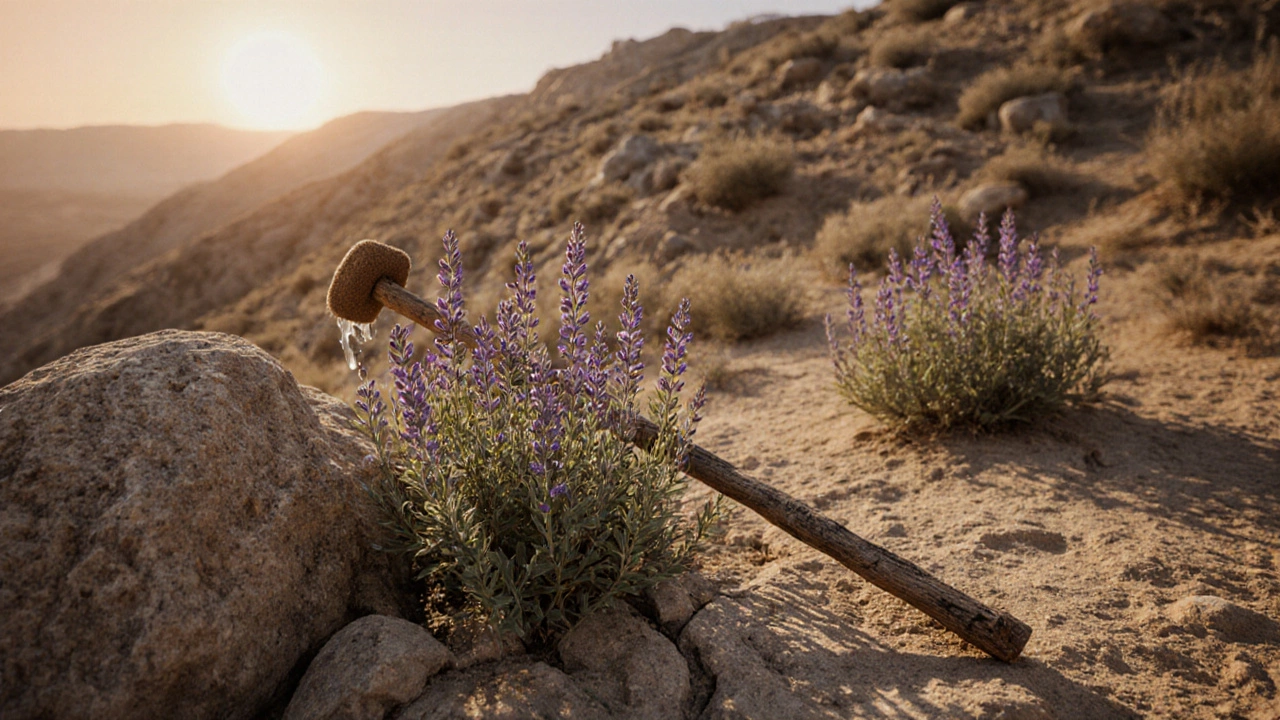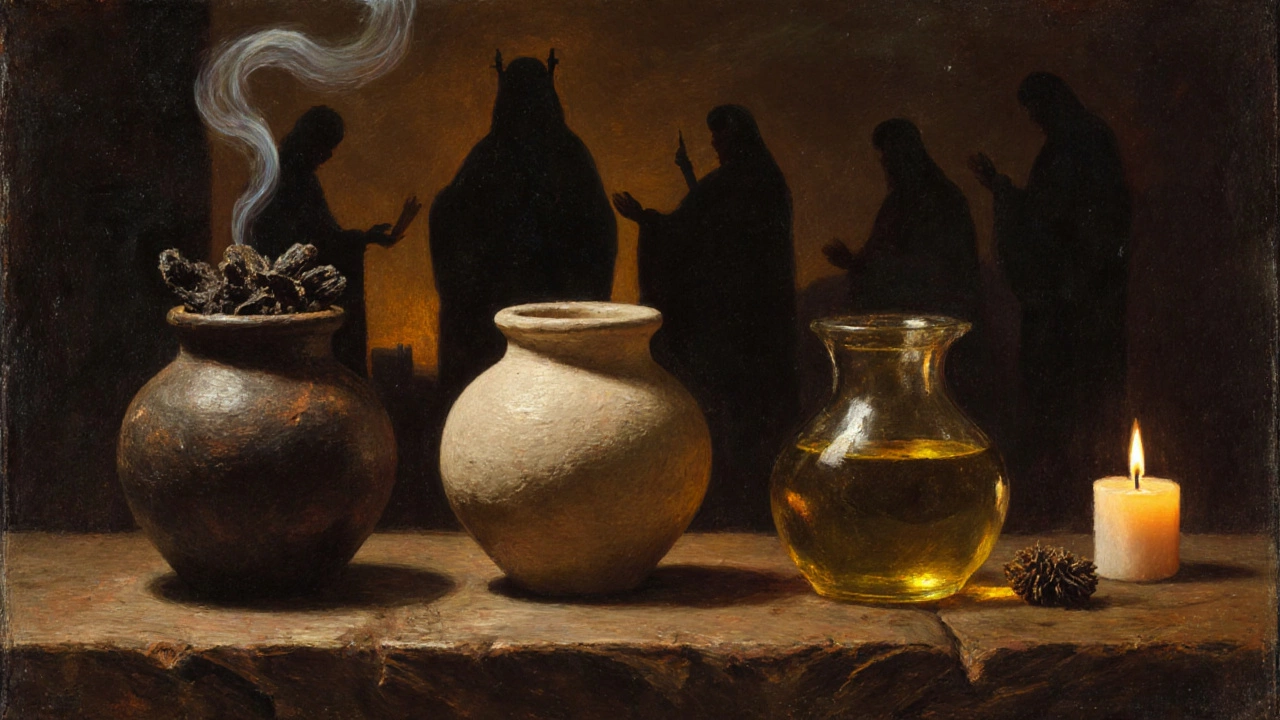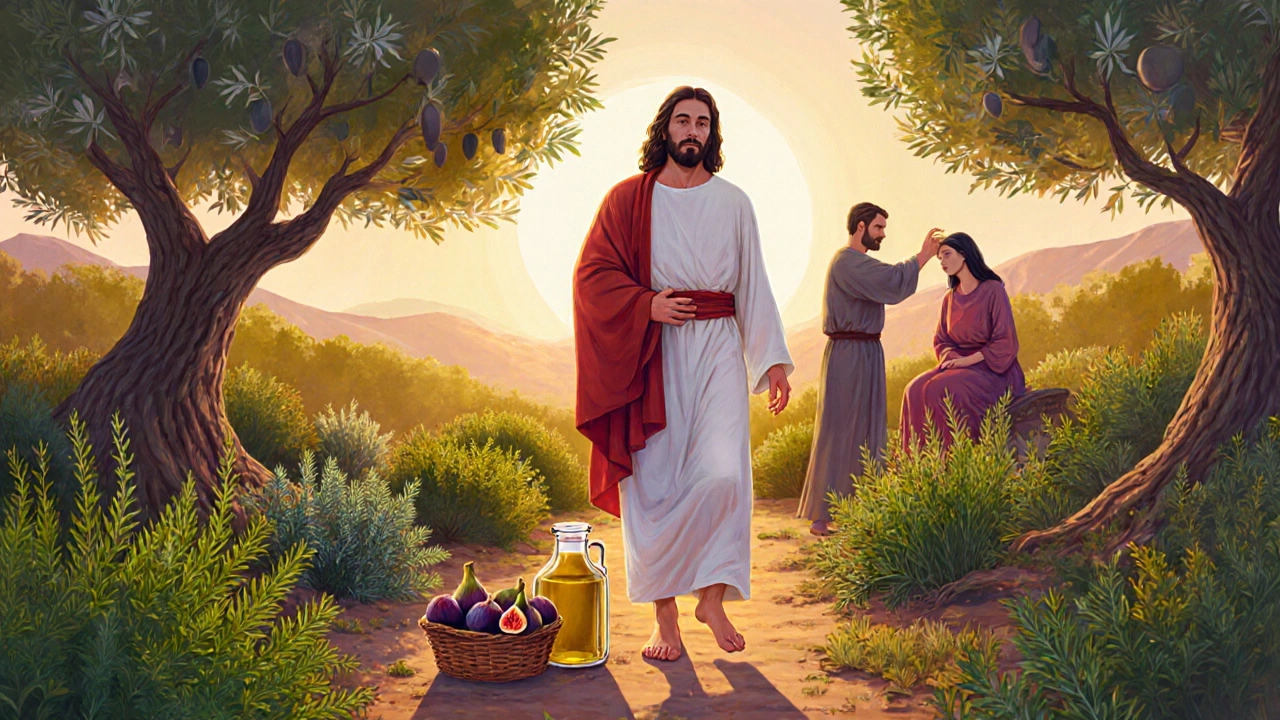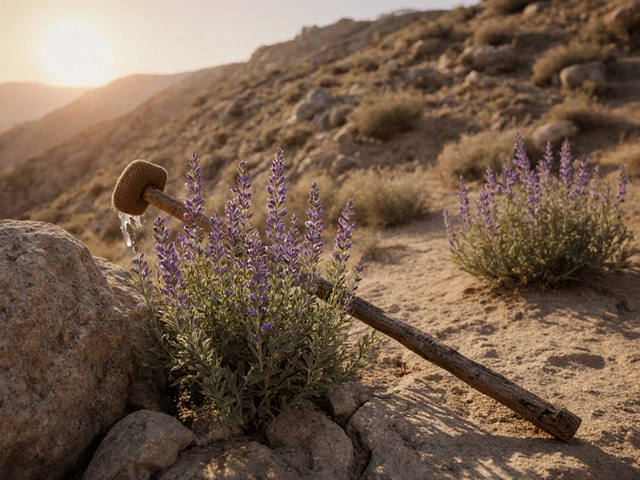- Home
- Herbal Medicine
- What herb did Jesus use? Historical and biblical insights into herbs in ancient times

What herb did Jesus use? Historical and biblical insights into herbs in ancient times
Biblical Herb Usage Calculator
Discover Ancient Herb Applications
Herb Application Results
When people ask what herb Jesus used, they’re often looking for more than a list of plants. They want to understand the world he lived in - how people healed, worshipped, and survived with what nature provided. The Bible doesn’t read like a herbal guidebook, but if you look closely, certain plants show up again and again - not as decorations, but as tools of healing, ritual, and everyday life.
Hyssop: The Cleansing Herb
Hyssop is mentioned more than any other herb in the New Testament. In John 19:29, a sponge soaked in vinegar is lifted to Jesus on a branch of hyssop just before his death. That moment isn’t just a detail - it’s loaded with meaning. In the Old Testament, hyssop was used to sprinkle blood during the Passover (Exodus 12:22) and to cleanse people from leprosy (Leviticus 14:4-7). It wasn’t a luxury. It grew wild in the hills around Jerusalem, tough and aromatic, with small purple flowers. People used it to sweep floors, wash wounds, and purify spaces. It’s likely the most common herb in daily use, not because it was magical, but because it was everywhere.
Myrrh: The Gift of Healing and Burial
Myrrh shows up early - in the story of Jesus’ birth. The Magi brought it as one of three gifts (Matthew 2:11). It wasn’t just a fancy perfume. Myrrh was a resin pulled from thorny trees in Arabia and Somalia. It was expensive, hard to get, and used in medicine, embalming, and sacred oils. Ancient Egyptians used it to preserve bodies. Jewish families used it to anoint the dead. It had antiseptic properties. If you were wounded or sick, myrrh was one of the few things that could help prevent infection. It’s no coincidence that after Jesus’ crucifixion, Nicodemus brought a mixture of myrrh and aloes (about 75 pounds) to wrap his body (John 19:39). This wasn’t just tradition - it was practical care.
Frankincense: The Sacred Smoke
Frankincense was the third gift from the Magi. Like myrrh, it came from resin, but this time from Boswellia trees. It was burned in temples, synagogues, and homes to create a calming, aromatic smoke. Priests used it in daily rituals. The smell was meant to lift the spirit - and it did. Modern studies show frankincense has anti-inflammatory compounds that may help with arthritis and gut issues. Back then, people didn’t know about compounds, but they knew smoke cleared the air, calmed the mind, and made prayer feel different. It wasn’t just religious - it was medicine.

Other Plants in Daily Life
Jesus didn’t just use herbs in rituals. He ate them. He likely knew the taste of mint, dill, and cumin - spices tithed by Pharisees (Matthew 23:23). He walked past gardens where people grew garlic for infections, onions for digestion, and figs for their natural sugars and fiber. Figs were so common they’re mentioned over 50 times in the Bible. Olive oil wasn’t just for cooking - it was used to rub on sore muscles, treat burns, and anoint the sick. Even the bread he broke was made from barley or wheat, both of which were grown with herbal crop rotations to keep soil healthy.
There’s no record of Jesus prescribing herbs like a modern herbalist. But he used them. He healed with touch, yes - but also with oil, with water, with food. He didn’t reject nature. He worked with it. In Mark 6:13, his disciples anointed the sick with oil and healed them. That oil wasn’t plain - it was likely infused with herbs like rosemary, thyme, or lavender, all common in the region and known for their soothing properties.
Why This Matters Today
People today buy expensive herbal supplements claiming to be ‘biblical’ or ‘Jesus-approved.’ But the herbs used back then weren’t pills. They weren’t standardized extracts. They were grown in dirt, harvested by hand, and used fresh or dried. There was no FDA, no lab testing - just generations of observation. If you want to connect with what Jesus used, you don’t need a $50 bottle of ‘Holy Hyssop Extract.’ You need to understand context. Hyssop was a scrub brush. Myrrh was a wound salve. Frankincense was incense for prayer. These weren’t magic potions - they were tools.
Modern herbal medicine has its place. But if you’re looking for authenticity, don’t chase branded supplements. Look at the plants still growing in the Middle East today. Try making a simple tea from dried mint or thyme. Rub olive oil on your skin. Light frankincense resin on charcoal. These are the real connections - not the marketing.

What We Know for Sure
There’s no evidence Jesus used cannabis, psilocybin, or any other psychoactive plant. Those ideas are modern projections. The herbs tied to him are the ones documented in scripture and archaeology: hyssop, myrrh, frankincense, olive oil, and common kitchen herbs like dill and cumin. These weren’t exotic. They were ordinary - which makes them powerful. Healing didn’t come from rarity. It came from care, from presence, from using what was available with intention.
Did Jesus use marijuana or psychedelic herbs?
No. There’s no historical, biblical, or archaeological evidence that Jesus used marijuana, psilocybin mushrooms, or any other psychoactive substances. The herbs mentioned in the Bible - hyssop, myrrh, frankincense, olive oil - were all non-intoxicating and used for healing, ritual, or food. Claims about Jesus using psychedelics are modern myths with no basis in ancient texts or practices.
What’s the difference between myrrh and frankincense?
Myrrh is a dark, sticky resin from the Commiphora tree, used for wound care, embalming, and as an antiseptic. Frankincense comes from the Boswellia tree and is a pale, fragrant resin burned as incense for prayer and purification. Myrrh has a bitter, earthy smell; frankincense is sweet and citrusy. Both were valuable, but used differently - one for healing the body, the other for cleansing the spirit.
Can I grow hyssop today?
Yes. Hyssop (Hyssopus officinalis) is a hardy perennial herb that grows well in sunny, well-drained soil. It’s available at most garden centers and thrives in zones 4-9. You can use the leaves fresh or dried in teas, or as a mild antiseptic wash. It’s not a miracle cure, but it’s a direct link to the plants used in ancient times.
Were these herbs used only by religious people?
No. Herbs like hyssop, myrrh, and olive oil were part of everyday life - used by farmers, merchants, mothers, and soldiers. Religion gave them symbolic meaning, but their practical use was universal. A mother might rub olive oil on her child’s chest for a cough. A soldier might clean a wound with hyssop tea. They weren’t holy because they were used in rituals - they were used in rituals because they worked.
Is there any modern research on these biblical herbs?
Yes. Studies have shown that myrrh has antimicrobial properties and may help with oral inflammation. Frankincense contains boswellic acids, which reduce inflammation and may ease joint pain. Hyssop has been studied for its antiviral effects. These aren’t new discoveries - they’re validations of ancient knowledge. The science is catching up to what people knew by trial and error thousands of years ago.
What to Do Next
If you’re curious about these herbs, start simple. Buy a small bottle of pure olive oil. Rub a few drops on your hands before bed. Light a stick of frankincense incense while you sit quietly. Brew a cup of dried hyssop or mint tea. Don’t expect miracles. Expect connection. These aren’t just ancient plants - they’re reminders that healing has always been about the natural world, used with care and attention.
The real herb Jesus used wasn’t one plant. It was the combination of knowledge, humility, and presence. That’s still the most powerful remedy of all.

Arnav Singh
I am a health expert with a focus on medicine-related topics in India. My work involves researching and writing articles that aim to inform and educate readers about health and wellness practices. I enjoy exploring the intersections of traditional and modern medicine and how they impact healthcare in the Indian context. Writing for various health magazines and platforms allows me to share my insights with a wider audience.
About
Medical Resource Center India is a comprehensive online platform dedicated to providing reliable health information and medical resources in India. Explore a wide range of articles, tips, and advice on medicine, healthcare services, and wellness. Stay informed about the latest developments in Indian medicine and access valuable insights into maintaining a healthy lifestyle. Discover expert guidance and health solutions tailored for every Indian citizen. Your go-to destination for authoritative medical knowledge in India.






